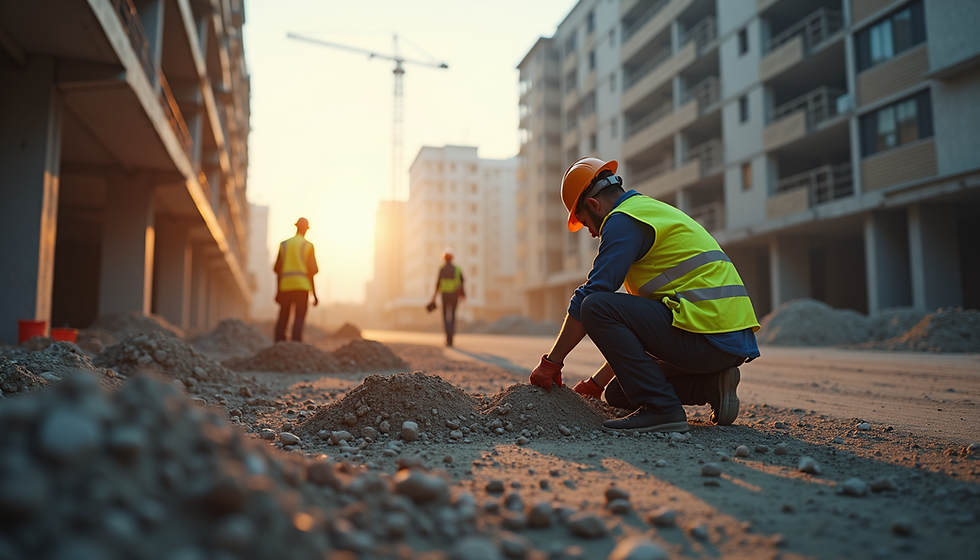Innovative Architecture and Construction: Transforming Spaces with Style
- YOLLA ink

- Sep 12
- 4 min read
Architecture and construction are not just about building structures. They are about creating spaces that inspire, engage, and transform lives. In today's world, innovative architecture and construction techniques are reshaping our environments. They are making our spaces more functional, sustainable, and aesthetically pleasing.
This blog post will explore the latest trends in architecture and construction. We will look at how these innovations are changing the way we live and work. From sustainable materials to smart technology, the future of architecture is bright and exciting.
The Rise of Sustainable Architecture
Sustainable architecture is more than a trend; it is a necessity. As climate change becomes a pressing issue, architects are focusing on designs that minimize environmental impact.
Key Features of Sustainable Architecture
Energy Efficiency: Buildings are designed to use less energy. This includes better insulation, energy-efficient windows, and solar panels.
Sustainable Materials: Architects are using materials that are renewable and recyclable. Bamboo, reclaimed wood, and recycled metal are popular choices.
Water Conservation: Innovative designs include rainwater harvesting systems and greywater recycling. These features help reduce water usage.
Green Spaces: Incorporating plants and green roofs into designs improves air quality and provides natural beauty.
For example, the Bosco Verticale in Milan, Italy, features residential towers covered in trees and plants. This design not only looks stunning but also helps combat air pollution.
Smart Technology in Construction
Technology is revolutionizing the construction industry. Smart technology is making buildings more efficient and user-friendly.
Benefits of Smart Technology
Automation: Smart homes can control lighting, heating, and security systems with a simple app. This convenience enhances the living experience.
Data-Driven Design: Architects can use data to understand how spaces are used. This information helps create designs that meet the needs of occupants.
Improved Safety: Smart technology can monitor buildings for potential hazards. This includes fire alarms, security cameras, and structural health monitoring.
A great example of smart technology in action is the Edge in Amsterdam. This office building uses sensors to optimize energy use and enhance employee comfort.
Biophilic Design: Connecting with Nature
Biophilic design is about creating a connection between people and nature. This approach enhances well-being and productivity.
Elements of Biophilic Design
Natural Light: Large windows and open spaces allow natural light to flood in. This creates a warm and inviting atmosphere.
Natural Materials: Using wood, stone, and other natural materials brings the outdoors inside.
Views of Nature: Designing spaces with views of gardens, parks, or water features can reduce stress and improve mood.
The Amazon Spheres in Seattle are a perfect example of biophilic design. These glass domes house thousands of plants and provide a unique workspace for employees.
Modular Construction: Efficiency and Flexibility
Modular construction is changing how buildings are made. This method involves creating sections of a building off-site and then assembling them on location.
Advantages of Modular Construction
Speed: Building modules can be constructed simultaneously with site preparation. This reduces overall construction time.
Cost-Effectiveness: Less waste and faster construction lead to lower costs.
Flexibility: Modular buildings can be easily expanded or reconfigured as needs change.
A notable example is the Marriott International's modular hotel project. They have successfully built hotels using modular construction, significantly reducing the time to open new locations.
The Importance of Community-Centric Design
Architecture should not only focus on individual needs but also consider the community. Community-centric design fosters social interaction and inclusivity.
Features of Community-Centric Design
Public Spaces: Parks, plazas, and community centers encourage social gatherings and activities.
Accessibility: Designs should be inclusive for people of all abilities. This includes ramps, elevators, and clear signage.
Cultural Reflection: Architecture should reflect the local culture and history, creating a sense of belonging.
The High Line in New York City is a prime example of community-centric design. This elevated park transformed an old railway into a vibrant public space that connects neighborhoods.
The Future of Architecture and Construction
As we look to the future, the possibilities in architecture and construction are endless. Innovations will continue to emerge, driven by technology, sustainability, and the need for better living spaces.
Trends to Watch
3D Printing: This technology is making it possible to create entire buildings quickly and affordably.
Virtual Reality: Architects can use VR to create immersive experiences for clients, allowing them to visualize designs before construction begins.
Resilient Design: As climate change impacts become more severe, buildings will need to be designed to withstand extreme weather events.
The future of architecture is not just about aesthetics; it is about creating spaces that enhance our lives and protect our planet.
Embracing Change in Architecture
The world of architecture and construction is evolving rapidly. Embracing these changes can lead to innovative solutions that benefit everyone.
How to Get Involved
Stay Informed: Follow industry news and trends to understand the latest innovations.
Support Sustainable Practices: Choose to work with architects and builders who prioritize sustainability.
Engage with Your Community: Participate in local planning meetings and advocate for designs that benefit everyone.
By being proactive, we can all contribute to a future where architecture and construction enhance our lives and the environment.

In summary, innovative architecture and construction are transforming our spaces with style. From sustainable practices to smart technology, the future is bright. By embracing these changes, we can create environments that inspire and uplift. The journey of architecture is just beginning, and it is an exciting time to be a part of it.



Comments